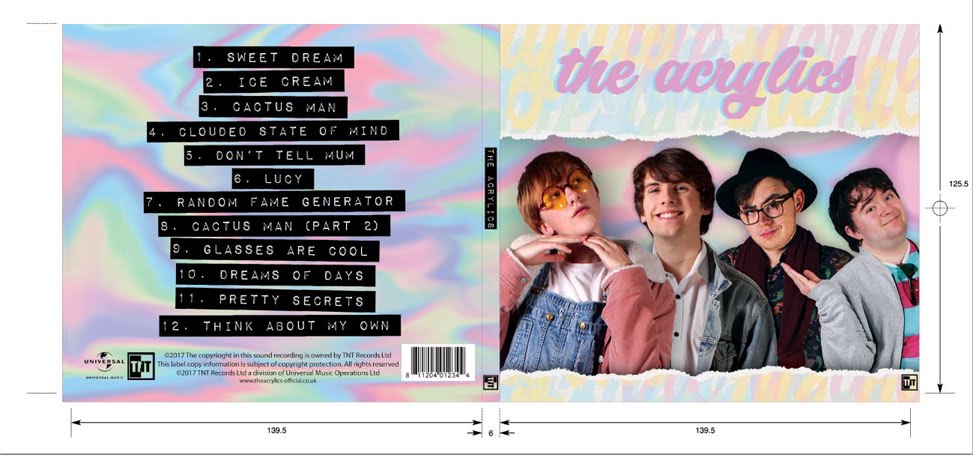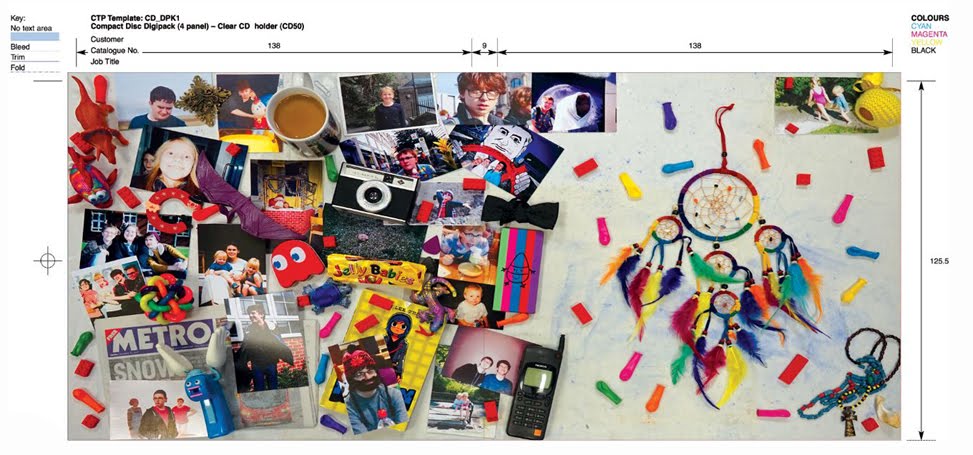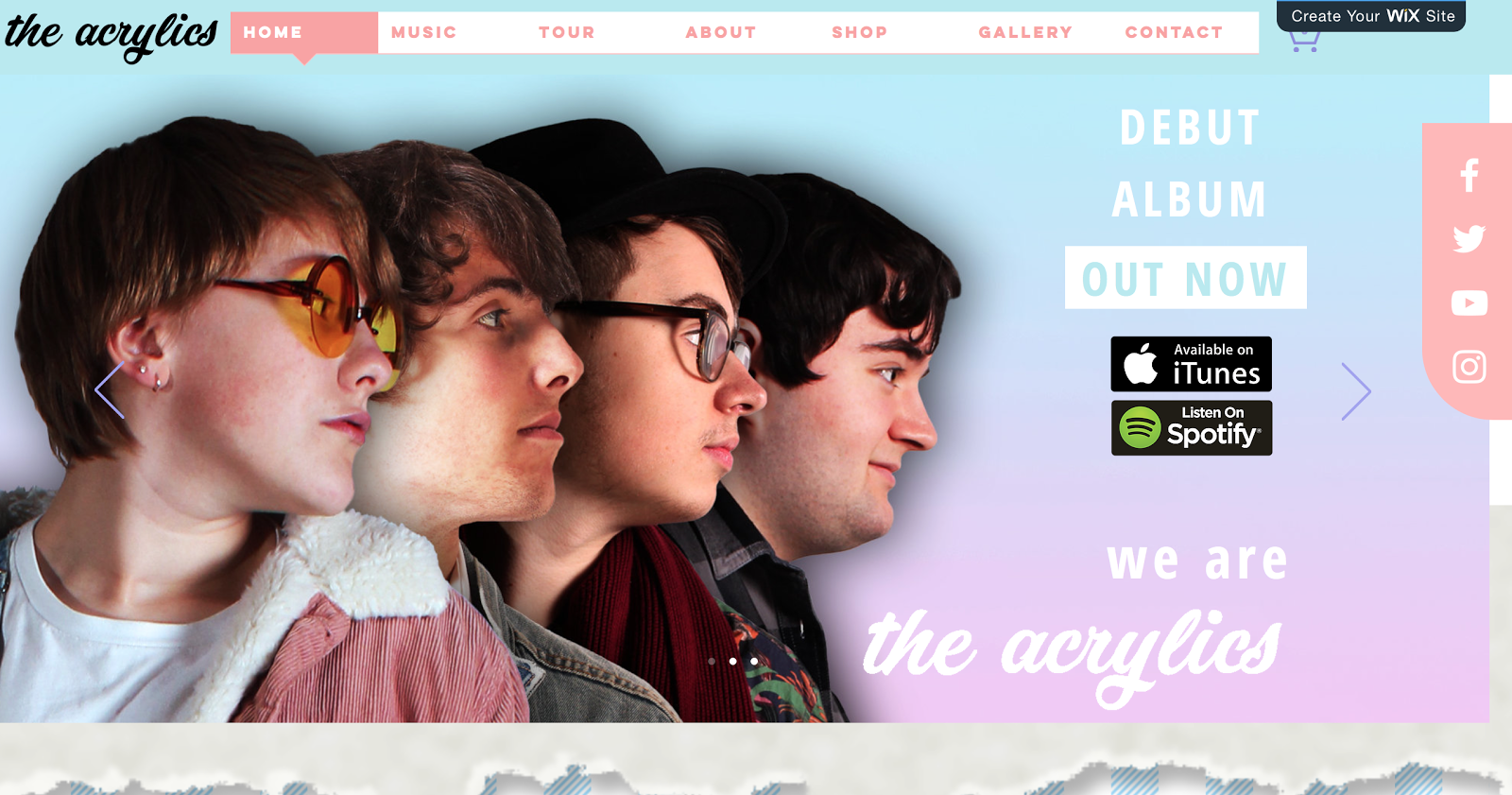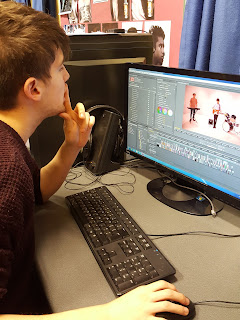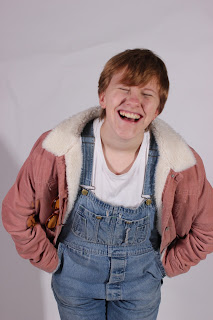What we needed:
- A blog style website
- Lots of opportunities for interaction
- Lots of opportunities to purchase (both merchandise and the album)
- Lots of opportunities to inform the user about the band
- A colourful, quirky aesthetic that synergises with the branding of our other products
I created the website on Wix.com. Wix.com was a surprisingly easy piece of software that allowed me to create the website the way I wanted. It had a variety of different layouts for me to choose from when I first logged on. This was helpful as I could find a template for a blog styled website and adjust it from there to create our band's website, which saved time having to create the tools to make the blog aspect of the website aesthetic work.
There were lots of tools that allowed for interaction, information and purchase, including:
- Slideshows and gallery - the user can cycle through images and links that discover more about the artist and allow more interactive ways of finding new parts of the site other than scrolling down.
- Hover boxes - the user can hover over boxes and it will reveal something new. I used this for the info boxes on each of the members of the band so the audience could fulfil their curiosity and discover more information about the band.
- Light boxes - the user will be introduced to the website with a page before they can enter the website, which will promote the album and provide a link for where the user can purchase it, and listen to it on Spotify and iTunes. The user can close this to continue to the website, where their are plenty of other opportunities to purchase the album inside.
The pre-prepared tools were easily adjustable to suit our needs; for instance, images could be quickly adjusted in contrast, brightness etc. and pastel colours and rounded borders could be used to make our website suit our fun, colourful band aesthetic.
I learned a lot about web design in the process of this construction task. Before the construction task, I had only used Wix.com once in preparation for this activity, and although I got an idea of how the software looked and how to use the menu to find my tools, I have gained hands on skills using web design software and I now feel much more confident in using Wix.com to create intended effects. I have also learned a lot about laying out websites clearly and the importance of allowing lots of facilities for the user to find their way around the website; for example, I found I was using the 'Button' icon a lot to link the user from various sub pages back to the main page, and I was linking various images to do with the album to the shop to allow the user opportunities and free reign on when they wanted to purchase.
I learned a lot about web design in the process of this construction task. Before the construction task, I had only used Wix.com once in preparation for this activity, and although I got an idea of how the software looked and how to use the menu to find my tools, I have gained hands on skills using web design software and I now feel much more confident in using Wix.com to create intended effects. I have also learned a lot about laying out websites clearly and the importance of allowing lots of facilities for the user to find their way around the website; for example, I found I was using the 'Button' icon a lot to link the user from various sub pages back to the main page, and I was linking various images to do with the album to the shop to allow the user opportunities and free reign on when they wanted to purchase.
Wix.com ticked all the boxes for our needs. The only problems I faced using the software was that it was liable to lagging and crashing. This was frustrating and time wasting in our limited time constraints, but did not prevent the overall progress of the construction drastically.
Other software I used were:
Adobe Photoshop - each promotional photograph featured on the website needed some work on this software before it could be put onto the website, including shot healing, colour adjustment and so forth. I could also create banners and posters to be featured on the website, including the 'we are The Acrylics' banner on the homepage slideshow, and the tour poster. I also needed Photoshop to create the merchandise, which would need to feature our logo and/or some lyrics and colours associated with our brand.
Audacity - I briefly used audacity to create sound files for the music page of our website.
My contribution
During the construction of the website, I :
My contribution
During the construction of the website, I :
- Headed the website task and made some executive decisions on the website, which I then verified with the rest of my group
- Used web tools to create interactive effects on the website
- Created some promotional material using Photoshop, including the tour poster and the 'we are The Acrylics' banner
- Created merchandise that can be sold using Photoshop
- Set up Ticketmaster and Bandsintown accounts for the user to access when finding out about tour information
Challenges we faced and how we overcame them:
Besides lagging from the website, most of the problems we had with the website we worked around through problem solving and by gaining more knowledge on how Wix.com worked.
For instance, we wanted to link pictures of the band members to their personal galleries, where the user could cycle through the pictures at will. However, there was no tool to link a picture to a gallery. We could, however, link the picture to a light box, so what we did was create a gallery, then put the gallery onto the light box and link the image to the light box. This way, the user could be taken to the galleries of each band member without being taken into a new page, which made it easier to go back to the original page once they had looked through the gallery.
Here is our finished website:
Besides lagging from the website, most of the problems we had with the website we worked around through problem solving and by gaining more knowledge on how Wix.com worked.
For instance, we wanted to link pictures of the band members to their personal galleries, where the user could cycle through the pictures at will. However, there was no tool to link a picture to a gallery. We could, however, link the picture to a light box, so what we did was create a gallery, then put the gallery onto the light box and link the image to the light box. This way, the user could be taken to the galleries of each band member without being taken into a new page, which made it easier to go back to the original page once they had looked through the gallery.
Here is our finished website:
